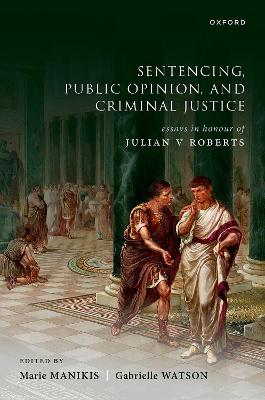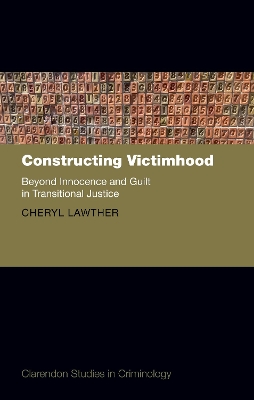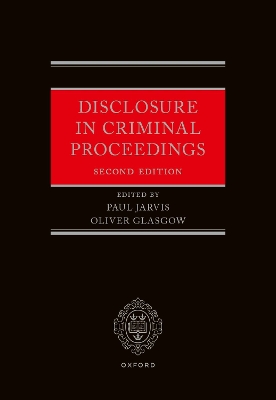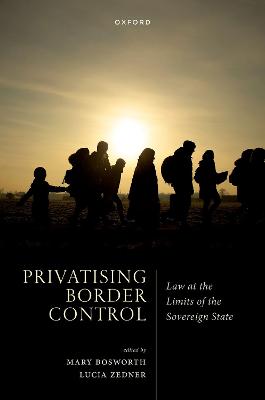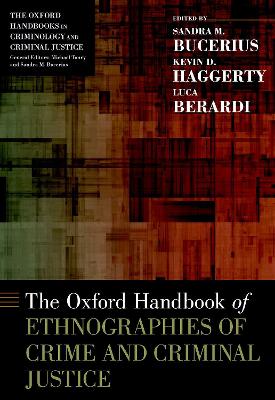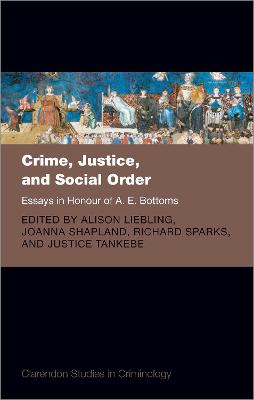Real Criminology
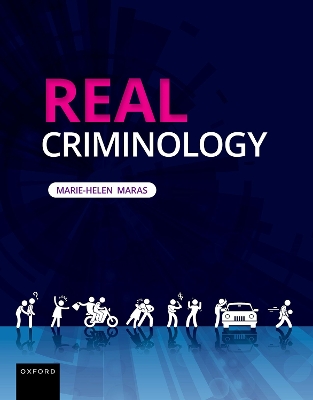 -10%
portes grátis
-10%
portes grátis
Real Criminology
Maras, Marie-Helen
Oxford University Press Inc
10/2024
416
Mole
Inglês
9780190904029
15 a 20 dias
Descrição não disponível.
Part 1: THE NATURE AND EXTENT OF CRIME
Chapter 1: Crime and Criminology
1.1: Crime, Law, and Justice
1.1.1:. Classifications of Crime
1.1.2: The Evolution of Crime
1.1.3: Criminal Justice
1.2: Criminology
1.2.1: What Do Criminologists Do?
1.2.2: Theories of Crime
1.2.3: Cybercriminology
1.3: Critiques and Implications of Crime, Law, Justice, and Criminology
Case Study: Don't F**k With Cats
Check Your Understanding
Key Terms
Definitions
Endnotes
Chapter 2: Measuring Crime
2.1: Reporting and Measuring Crime
2.1.1: Uniform Crime Reporting Program
2.1.2: National Incident Based Reporting System
2.1.3: National Crime Victimization Survey
2.1.4: Self-Report Surveys
2.1.5: International Crime Measurement Tools
2.2: The Dark Figure of Crime
2.3: Cybercrime Measurement
2.4: Critiques and Implications of Crime Measurement Tools
Case Study: Evaluating Crime Measurement Tools
Check Your Understanding
Key Terms
Chapter 3: Victims and Victimization
3.1: The Impacts of Victimization
3.1.1: Direct Costs
3.1.2: Indirect Costs
3.2: Victims' Attributes
3.2.1: Demographics
3.2.2: Victim-Offender Relationship and Race/Ethnicity
3.2.3: Repeat Victimization
3.3: Victimization Theories
3.3.1: Victim Precipitation Theory
3.3.2: Lifestyle Exposure Theory
3.3.3: Routine Activity Theory
3.3.4: Critiques and Implications of Victimization Theories
3.4: Victim Blaming and Secondary Victimization
3.4.1: Explanations of Victim-Blaming Behavior
3.4.2: Rape Myths
3.4.3: Secondary Victimization
3.5: Victims' Rights
3.5.1: Campaigns for Women's Rights
3.5.2: The Crime Victims' Rights Act
3.5.3: Victim Services
3.5.4: Victim Impact Statements
Case Study: Applying Victimization Theory to Child Sexual Assault
Check Your Understanding
Key Terms
Definitions
Endnotes
Part 2: CRIME CAUSATION AND REDUCTION
Chapter 4: Rational Choice Theory
4.1: The Idea of Crime as a Rational Choice
4.1.1: The Classical School of Criminology
4.1.2: Components of Rational Choice Theory
4.2: Responding to Crime
4.2.1: Retribution
4.2.2: Deterrence
4.2.3: Incapacitation
4.2.4: Rehabilitation
4.3: Reducing Crime
4.3.1: International Cooperation
4.3.2: Situational Crime Prevention
4.3.3: Displacement
4.3.4: Commodification of Security
4.4: Critiques and Implications of Theories
Case Study: Applying Rational Choice Theory to Terrorism
Check Your Understanding
Key Terms
Definitions
Endnotes
Chapter 5: Trait Theories: Biological and Psychological Predisposition
5.1: The Positivist School and Trait Theories
5.2: Biological Trait Theories: Criminals Are Born, Not Made
5.2.1: Physiological Characteristics
5.2.2: Evolution
5.2.3: Biochemical Influences
5.2.4: Neurological Influences
5.3: Psychological Theories: The New Positivists
5.3.1: Intelligence
5.3.2: Mental Disorders
5.3.3: Personality Theories
5.3.4: Emotions
5.3.5: Psychoanalytical Theories
5.3.6: Attachment Theory
5.4: Critiques and Implications of Theories
Case Study: Applying Trait Theories to Mass Murder
Check Your Understanding
Key Terms
Definitions
Endnotes
Chapter 6: Social Structure Theories: Crime, Culture and Inequality
6.1: Social Structure Theories
6.1.1: Chicago School of Criminology
Human Ecology and Concentric Zones
Social Disorganization Theory
Hot Spots, Crime Mapping, and Deviant Places
Social Capital and Collective Efficacy
Broken Windows Theory
6.2: Strain Theories
6.2.1: Anomie: Concept and Theory
6.2.2: Relative Deprivation Theory
6.2.3: Institutional Anomie Theory
6.2.4: General Strain Theory
Sources and Management of Strain
6.3: Cultural Deviance Theories
6.3.1: Theory of Delinquent Subcultures
6.3.2: Theory of Differential Opportunity
6.4: Critiques and Implications of Theories
Case Study: Applying Social Structure Theory to Fraud
Check Your Understanding
Key Terms
Definitions
Endnotes
Chapter 7: Social Process Theories: Conformity, Learning, and Sources of Social Control
7.1: Controlling Criminality
7.2: Learning Criminality
7.3: Neutralizing Offenses
7.4: Moral Disengagement
7.5: Developmental and Life Course Criminology
7.5.1: Latent Trait Perspective
Control Balance Theory
General Theory of Crime
7.5.2: Life Course Perspective
7.6: Critiques and Implications of Theories
Case Study: Applying Social Process Theories to Involuntary Manslaughter
Check Your Understanding
Key Terms
Definitions
Endnotes
Chapter 8: Labeling and Moral Panics: Constructing and Reacting to Crime
8.1: The Label of Deviant or Criminal
8.1.1: Crime as Theater
8.1.2: Crime Through the Lens of Social Psychology
8.1.3: Implications of the Deviant or Criminal Label
8.2: Shaming and Sanctions
8.2.1: Reintegrative and Disintegrative Shaming
8.2.2: Public Shaming
8.2.3: Online Shaming and Trial by Internet
8.2.4: Shaming Sanctions
8.2.5: Defiance Theory
8.3: Moral Panics and Social Contagion
8.3.1: Moral Panics
8.3.2: Social Contagion
8.3.3: Theories and Perspectives on Moral Panics
8.4: Critiques and Implications of Theories
Case Study: Applying Moral Panics to Comic Books
Check Your Understanding
Key Terms
Definitions
Endnotes
Chapter 9: Conflict Criminology: Effects of Class, Power, Gender, and Race
9.1: Introducing Conflict Theories
9.2: Types of Conflict Criminology
9.2.1: Radical Criminology
9.2.2: Left Realism
9.2.3: Peacemaking Criminology
9.2.4: Feminist Criminology
Women and Criminological Theory
Gendered Perspectives on Crime
9.2.5: Race and Crime
9.3: Critiques and Implications
Case Study: Applying Conflict Criminology to the Criminal Justice System's Responses to Racial Minorities
Check Your Understanding
Key Terms
Definitions
Endnotes
Part 3: CRIME TYPOLOGIES
Chapter 10: Antisocial Behavior and Interpersonal Crime
10.1: Criminal Antisocial Behavior
10.1.1: Trolling
10.1.2: Bullying
10.1.3: Harassment
10.1.4: Stalking
10.2: Family and Intimate Partner Violence
10.2.1: Domestic Violence
10.2.2: Marital and Intimate Partner Rape
10.2.3: Murder
10.2.4: Child Maltreatment
10.2.5: Elder Abuse
10.2.6: Honor Killings
10.3: Community Violence
10.3.1: Assault
10.3.2: Robbery
10.3.3: Sexual Abuse
10.3.4: Mass, Spree, and Serial Murder
10.3.5: Hate Crime
10.3.6: Active Shooting
Workplace Violence
School Shooting
10.4: Controlling Antisocial Behavior and Interpersonal Crime
Challenging Your Assumptions
Case Study: Controlling Active Shooter Incidents
Check Your Understanding
Key Terms
Endnotes
Chapter 11: Property Crime and White-Collar Crime
11.1: Property Crime
11.1.1: Larceny-Theft
11.1.2: Trespass
11.1.3: Vandalism
11.1.4: Burglary
11.1.5: Shoplifting
11.1.6: Motor Vehicle Theft
11.1.7: Arson
11.1.8: Identity Theft
11.1.9: Intellectual Property Theft
11.1.10: Fraud
Bank Fraud
Phishing
Advance Fee Fraud
Catfishing
11.1.11: Extortion
11.2: White-Collar Crime
11.2.1: Bribery and Public Corruption
11.2.2: Securities Fraud
11.2.3: Insider Trading
11.2.4: Bankruptcy Fraud
11.2.5: Insurance Fraud
11.2.6: Healthcare Fraud
11.3: Controlling Property Crime and White-Collar Crime
Case Study: Applying Techniques to Prevent White-Collar Crime
Check Your Understanding
Key Terms
Definitions
Endnotes
Chapter 12: Deviant Acts and Public Order Crimes: Paraphilia, Sex Work, Drug Use, and Gambling
12.1: The Relationship Between Law and Morality
12.2: Deviance
12.3: Public Order Crimes
12.3.1: Sex Work
The Impacts Associated with the Sex Work
Sex Work and the Law
12.3.2: Drug Use and Crime
Substance Abuse
Prescription Drugs and the Law
12.3.3: Gambling
Addiction
Gambling and the Law
Sports Betting
Internet Gambling
12.4: Controlling Deviance and Public Order Crimes
Case Study: Sugaring
Check Your Understanding
Key Terms
Endnotes
Chapter 13: Transnational Organized Crime
13.3: Organized Crime
13.3.1: Group Structure
13.3.2: Criminal Activities
Money Laundering
Cybercrime
3.4: Trafficking in Persons
13.2.1: Sex Trafficking
13.2.2: Labor Trafficking
13.2.3: Organ Trafficking
13.3: Human Smuggling
13.4: Drugs Trafficking
13.5: Firearms Trafficking
13.6: Cigarette Trafficking
13.7: Precious Metals and Gemstones Trafficking
13.8: Cultural Property Trafficking
13.9: Environmental Crime
13.9.1: Wildlife Crime
13.9.2: Pollution Crime
13.10: Controlling Transnational Organized Crime and Cybercrime
Case Study: Controlling Wildlife Crime
Check Your Understanding
Key Terms
Definitions
Endnotes
Chapter 1: Crime and Criminology
1.1: Crime, Law, and Justice
1.1.1:. Classifications of Crime
1.1.2: The Evolution of Crime
1.1.3: Criminal Justice
1.2: Criminology
1.2.1: What Do Criminologists Do?
1.2.2: Theories of Crime
1.2.3: Cybercriminology
1.3: Critiques and Implications of Crime, Law, Justice, and Criminology
Case Study: Don't F**k With Cats
Check Your Understanding
Key Terms
Definitions
Endnotes
Chapter 2: Measuring Crime
2.1: Reporting and Measuring Crime
2.1.1: Uniform Crime Reporting Program
2.1.2: National Incident Based Reporting System
2.1.3: National Crime Victimization Survey
2.1.4: Self-Report Surveys
2.1.5: International Crime Measurement Tools
2.2: The Dark Figure of Crime
2.3: Cybercrime Measurement
2.4: Critiques and Implications of Crime Measurement Tools
Case Study: Evaluating Crime Measurement Tools
Check Your Understanding
Key Terms
Chapter 3: Victims and Victimization
3.1: The Impacts of Victimization
3.1.1: Direct Costs
3.1.2: Indirect Costs
3.2: Victims' Attributes
3.2.1: Demographics
3.2.2: Victim-Offender Relationship and Race/Ethnicity
3.2.3: Repeat Victimization
3.3: Victimization Theories
3.3.1: Victim Precipitation Theory
3.3.2: Lifestyle Exposure Theory
3.3.3: Routine Activity Theory
3.3.4: Critiques and Implications of Victimization Theories
3.4: Victim Blaming and Secondary Victimization
3.4.1: Explanations of Victim-Blaming Behavior
3.4.2: Rape Myths
3.4.3: Secondary Victimization
3.5: Victims' Rights
3.5.1: Campaigns for Women's Rights
3.5.2: The Crime Victims' Rights Act
3.5.3: Victim Services
3.5.4: Victim Impact Statements
Case Study: Applying Victimization Theory to Child Sexual Assault
Check Your Understanding
Key Terms
Definitions
Endnotes
Part 2: CRIME CAUSATION AND REDUCTION
Chapter 4: Rational Choice Theory
4.1: The Idea of Crime as a Rational Choice
4.1.1: The Classical School of Criminology
4.1.2: Components of Rational Choice Theory
4.2: Responding to Crime
4.2.1: Retribution
4.2.2: Deterrence
4.2.3: Incapacitation
4.2.4: Rehabilitation
4.3: Reducing Crime
4.3.1: International Cooperation
4.3.2: Situational Crime Prevention
4.3.3: Displacement
4.3.4: Commodification of Security
4.4: Critiques and Implications of Theories
Case Study: Applying Rational Choice Theory to Terrorism
Check Your Understanding
Key Terms
Definitions
Endnotes
Chapter 5: Trait Theories: Biological and Psychological Predisposition
5.1: The Positivist School and Trait Theories
5.2: Biological Trait Theories: Criminals Are Born, Not Made
5.2.1: Physiological Characteristics
5.2.2: Evolution
5.2.3: Biochemical Influences
5.2.4: Neurological Influences
5.3: Psychological Theories: The New Positivists
5.3.1: Intelligence
5.3.2: Mental Disorders
5.3.3: Personality Theories
5.3.4: Emotions
5.3.5: Psychoanalytical Theories
5.3.6: Attachment Theory
5.4: Critiques and Implications of Theories
Case Study: Applying Trait Theories to Mass Murder
Check Your Understanding
Key Terms
Definitions
Endnotes
Chapter 6: Social Structure Theories: Crime, Culture and Inequality
6.1: Social Structure Theories
6.1.1: Chicago School of Criminology
Human Ecology and Concentric Zones
Social Disorganization Theory
Hot Spots, Crime Mapping, and Deviant Places
Social Capital and Collective Efficacy
Broken Windows Theory
6.2: Strain Theories
6.2.1: Anomie: Concept and Theory
6.2.2: Relative Deprivation Theory
6.2.3: Institutional Anomie Theory
6.2.4: General Strain Theory
Sources and Management of Strain
6.3: Cultural Deviance Theories
6.3.1: Theory of Delinquent Subcultures
6.3.2: Theory of Differential Opportunity
6.4: Critiques and Implications of Theories
Case Study: Applying Social Structure Theory to Fraud
Check Your Understanding
Key Terms
Definitions
Endnotes
Chapter 7: Social Process Theories: Conformity, Learning, and Sources of Social Control
7.1: Controlling Criminality
7.2: Learning Criminality
7.3: Neutralizing Offenses
7.4: Moral Disengagement
7.5: Developmental and Life Course Criminology
7.5.1: Latent Trait Perspective
Control Balance Theory
General Theory of Crime
7.5.2: Life Course Perspective
7.6: Critiques and Implications of Theories
Case Study: Applying Social Process Theories to Involuntary Manslaughter
Check Your Understanding
Key Terms
Definitions
Endnotes
Chapter 8: Labeling and Moral Panics: Constructing and Reacting to Crime
8.1: The Label of Deviant or Criminal
8.1.1: Crime as Theater
8.1.2: Crime Through the Lens of Social Psychology
8.1.3: Implications of the Deviant or Criminal Label
8.2: Shaming and Sanctions
8.2.1: Reintegrative and Disintegrative Shaming
8.2.2: Public Shaming
8.2.3: Online Shaming and Trial by Internet
8.2.4: Shaming Sanctions
8.2.5: Defiance Theory
8.3: Moral Panics and Social Contagion
8.3.1: Moral Panics
8.3.2: Social Contagion
8.3.3: Theories and Perspectives on Moral Panics
8.4: Critiques and Implications of Theories
Case Study: Applying Moral Panics to Comic Books
Check Your Understanding
Key Terms
Definitions
Endnotes
Chapter 9: Conflict Criminology: Effects of Class, Power, Gender, and Race
9.1: Introducing Conflict Theories
9.2: Types of Conflict Criminology
9.2.1: Radical Criminology
9.2.2: Left Realism
9.2.3: Peacemaking Criminology
9.2.4: Feminist Criminology
Women and Criminological Theory
Gendered Perspectives on Crime
9.2.5: Race and Crime
9.3: Critiques and Implications
Case Study: Applying Conflict Criminology to the Criminal Justice System's Responses to Racial Minorities
Check Your Understanding
Key Terms
Definitions
Endnotes
Part 3: CRIME TYPOLOGIES
Chapter 10: Antisocial Behavior and Interpersonal Crime
10.1: Criminal Antisocial Behavior
10.1.1: Trolling
10.1.2: Bullying
10.1.3: Harassment
10.1.4: Stalking
10.2: Family and Intimate Partner Violence
10.2.1: Domestic Violence
10.2.2: Marital and Intimate Partner Rape
10.2.3: Murder
10.2.4: Child Maltreatment
10.2.5: Elder Abuse
10.2.6: Honor Killings
10.3: Community Violence
10.3.1: Assault
10.3.2: Robbery
10.3.3: Sexual Abuse
10.3.4: Mass, Spree, and Serial Murder
10.3.5: Hate Crime
10.3.6: Active Shooting
Workplace Violence
School Shooting
10.4: Controlling Antisocial Behavior and Interpersonal Crime
Challenging Your Assumptions
Case Study: Controlling Active Shooter Incidents
Check Your Understanding
Key Terms
Endnotes
Chapter 11: Property Crime and White-Collar Crime
11.1: Property Crime
11.1.1: Larceny-Theft
11.1.2: Trespass
11.1.3: Vandalism
11.1.4: Burglary
11.1.5: Shoplifting
11.1.6: Motor Vehicle Theft
11.1.7: Arson
11.1.8: Identity Theft
11.1.9: Intellectual Property Theft
11.1.10: Fraud
Bank Fraud
Phishing
Advance Fee Fraud
Catfishing
11.1.11: Extortion
11.2: White-Collar Crime
11.2.1: Bribery and Public Corruption
11.2.2: Securities Fraud
11.2.3: Insider Trading
11.2.4: Bankruptcy Fraud
11.2.5: Insurance Fraud
11.2.6: Healthcare Fraud
11.3: Controlling Property Crime and White-Collar Crime
Case Study: Applying Techniques to Prevent White-Collar Crime
Check Your Understanding
Key Terms
Definitions
Endnotes
Chapter 12: Deviant Acts and Public Order Crimes: Paraphilia, Sex Work, Drug Use, and Gambling
12.1: The Relationship Between Law and Morality
12.2: Deviance
12.3: Public Order Crimes
12.3.1: Sex Work
The Impacts Associated with the Sex Work
Sex Work and the Law
12.3.2: Drug Use and Crime
Substance Abuse
Prescription Drugs and the Law
12.3.3: Gambling
Addiction
Gambling and the Law
Sports Betting
Internet Gambling
12.4: Controlling Deviance and Public Order Crimes
Case Study: Sugaring
Check Your Understanding
Key Terms
Endnotes
Chapter 13: Transnational Organized Crime
13.3: Organized Crime
13.3.1: Group Structure
13.3.2: Criminal Activities
Money Laundering
Cybercrime
3.4: Trafficking in Persons
13.2.1: Sex Trafficking
13.2.2: Labor Trafficking
13.2.3: Organ Trafficking
13.3: Human Smuggling
13.4: Drugs Trafficking
13.5: Firearms Trafficking
13.6: Cigarette Trafficking
13.7: Precious Metals and Gemstones Trafficking
13.8: Cultural Property Trafficking
13.9: Environmental Crime
13.9.1: Wildlife Crime
13.9.2: Pollution Crime
13.10: Controlling Transnational Organized Crime and Cybercrime
Case Study: Controlling Wildlife Crime
Check Your Understanding
Key Terms
Definitions
Endnotes
Este título pertence ao(s) assunto(s) indicados(s). Para ver outros títulos clique no assunto desejado.
Part 1: THE NATURE AND EXTENT OF CRIME
Chapter 1: Crime and Criminology
1.1: Crime, Law, and Justice
1.1.1:. Classifications of Crime
1.1.2: The Evolution of Crime
1.1.3: Criminal Justice
1.2: Criminology
1.2.1: What Do Criminologists Do?
1.2.2: Theories of Crime
1.2.3: Cybercriminology
1.3: Critiques and Implications of Crime, Law, Justice, and Criminology
Case Study: Don't F**k With Cats
Check Your Understanding
Key Terms
Definitions
Endnotes
Chapter 2: Measuring Crime
2.1: Reporting and Measuring Crime
2.1.1: Uniform Crime Reporting Program
2.1.2: National Incident Based Reporting System
2.1.3: National Crime Victimization Survey
2.1.4: Self-Report Surveys
2.1.5: International Crime Measurement Tools
2.2: The Dark Figure of Crime
2.3: Cybercrime Measurement
2.4: Critiques and Implications of Crime Measurement Tools
Case Study: Evaluating Crime Measurement Tools
Check Your Understanding
Key Terms
Chapter 3: Victims and Victimization
3.1: The Impacts of Victimization
3.1.1: Direct Costs
3.1.2: Indirect Costs
3.2: Victims' Attributes
3.2.1: Demographics
3.2.2: Victim-Offender Relationship and Race/Ethnicity
3.2.3: Repeat Victimization
3.3: Victimization Theories
3.3.1: Victim Precipitation Theory
3.3.2: Lifestyle Exposure Theory
3.3.3: Routine Activity Theory
3.3.4: Critiques and Implications of Victimization Theories
3.4: Victim Blaming and Secondary Victimization
3.4.1: Explanations of Victim-Blaming Behavior
3.4.2: Rape Myths
3.4.3: Secondary Victimization
3.5: Victims' Rights
3.5.1: Campaigns for Women's Rights
3.5.2: The Crime Victims' Rights Act
3.5.3: Victim Services
3.5.4: Victim Impact Statements
Case Study: Applying Victimization Theory to Child Sexual Assault
Check Your Understanding
Key Terms
Definitions
Endnotes
Part 2: CRIME CAUSATION AND REDUCTION
Chapter 4: Rational Choice Theory
4.1: The Idea of Crime as a Rational Choice
4.1.1: The Classical School of Criminology
4.1.2: Components of Rational Choice Theory
4.2: Responding to Crime
4.2.1: Retribution
4.2.2: Deterrence
4.2.3: Incapacitation
4.2.4: Rehabilitation
4.3: Reducing Crime
4.3.1: International Cooperation
4.3.2: Situational Crime Prevention
4.3.3: Displacement
4.3.4: Commodification of Security
4.4: Critiques and Implications of Theories
Case Study: Applying Rational Choice Theory to Terrorism
Check Your Understanding
Key Terms
Definitions
Endnotes
Chapter 5: Trait Theories: Biological and Psychological Predisposition
5.1: The Positivist School and Trait Theories
5.2: Biological Trait Theories: Criminals Are Born, Not Made
5.2.1: Physiological Characteristics
5.2.2: Evolution
5.2.3: Biochemical Influences
5.2.4: Neurological Influences
5.3: Psychological Theories: The New Positivists
5.3.1: Intelligence
5.3.2: Mental Disorders
5.3.3: Personality Theories
5.3.4: Emotions
5.3.5: Psychoanalytical Theories
5.3.6: Attachment Theory
5.4: Critiques and Implications of Theories
Case Study: Applying Trait Theories to Mass Murder
Check Your Understanding
Key Terms
Definitions
Endnotes
Chapter 6: Social Structure Theories: Crime, Culture and Inequality
6.1: Social Structure Theories
6.1.1: Chicago School of Criminology
Human Ecology and Concentric Zones
Social Disorganization Theory
Hot Spots, Crime Mapping, and Deviant Places
Social Capital and Collective Efficacy
Broken Windows Theory
6.2: Strain Theories
6.2.1: Anomie: Concept and Theory
6.2.2: Relative Deprivation Theory
6.2.3: Institutional Anomie Theory
6.2.4: General Strain Theory
Sources and Management of Strain
6.3: Cultural Deviance Theories
6.3.1: Theory of Delinquent Subcultures
6.3.2: Theory of Differential Opportunity
6.4: Critiques and Implications of Theories
Case Study: Applying Social Structure Theory to Fraud
Check Your Understanding
Key Terms
Definitions
Endnotes
Chapter 7: Social Process Theories: Conformity, Learning, and Sources of Social Control
7.1: Controlling Criminality
7.2: Learning Criminality
7.3: Neutralizing Offenses
7.4: Moral Disengagement
7.5: Developmental and Life Course Criminology
7.5.1: Latent Trait Perspective
Control Balance Theory
General Theory of Crime
7.5.2: Life Course Perspective
7.6: Critiques and Implications of Theories
Case Study: Applying Social Process Theories to Involuntary Manslaughter
Check Your Understanding
Key Terms
Definitions
Endnotes
Chapter 8: Labeling and Moral Panics: Constructing and Reacting to Crime
8.1: The Label of Deviant or Criminal
8.1.1: Crime as Theater
8.1.2: Crime Through the Lens of Social Psychology
8.1.3: Implications of the Deviant or Criminal Label
8.2: Shaming and Sanctions
8.2.1: Reintegrative and Disintegrative Shaming
8.2.2: Public Shaming
8.2.3: Online Shaming and Trial by Internet
8.2.4: Shaming Sanctions
8.2.5: Defiance Theory
8.3: Moral Panics and Social Contagion
8.3.1: Moral Panics
8.3.2: Social Contagion
8.3.3: Theories and Perspectives on Moral Panics
8.4: Critiques and Implications of Theories
Case Study: Applying Moral Panics to Comic Books
Check Your Understanding
Key Terms
Definitions
Endnotes
Chapter 9: Conflict Criminology: Effects of Class, Power, Gender, and Race
9.1: Introducing Conflict Theories
9.2: Types of Conflict Criminology
9.2.1: Radical Criminology
9.2.2: Left Realism
9.2.3: Peacemaking Criminology
9.2.4: Feminist Criminology
Women and Criminological Theory
Gendered Perspectives on Crime
9.2.5: Race and Crime
9.3: Critiques and Implications
Case Study: Applying Conflict Criminology to the Criminal Justice System's Responses to Racial Minorities
Check Your Understanding
Key Terms
Definitions
Endnotes
Part 3: CRIME TYPOLOGIES
Chapter 10: Antisocial Behavior and Interpersonal Crime
10.1: Criminal Antisocial Behavior
10.1.1: Trolling
10.1.2: Bullying
10.1.3: Harassment
10.1.4: Stalking
10.2: Family and Intimate Partner Violence
10.2.1: Domestic Violence
10.2.2: Marital and Intimate Partner Rape
10.2.3: Murder
10.2.4: Child Maltreatment
10.2.5: Elder Abuse
10.2.6: Honor Killings
10.3: Community Violence
10.3.1: Assault
10.3.2: Robbery
10.3.3: Sexual Abuse
10.3.4: Mass, Spree, and Serial Murder
10.3.5: Hate Crime
10.3.6: Active Shooting
Workplace Violence
School Shooting
10.4: Controlling Antisocial Behavior and Interpersonal Crime
Challenging Your Assumptions
Case Study: Controlling Active Shooter Incidents
Check Your Understanding
Key Terms
Endnotes
Chapter 11: Property Crime and White-Collar Crime
11.1: Property Crime
11.1.1: Larceny-Theft
11.1.2: Trespass
11.1.3: Vandalism
11.1.4: Burglary
11.1.5: Shoplifting
11.1.6: Motor Vehicle Theft
11.1.7: Arson
11.1.8: Identity Theft
11.1.9: Intellectual Property Theft
11.1.10: Fraud
Bank Fraud
Phishing
Advance Fee Fraud
Catfishing
11.1.11: Extortion
11.2: White-Collar Crime
11.2.1: Bribery and Public Corruption
11.2.2: Securities Fraud
11.2.3: Insider Trading
11.2.4: Bankruptcy Fraud
11.2.5: Insurance Fraud
11.2.6: Healthcare Fraud
11.3: Controlling Property Crime and White-Collar Crime
Case Study: Applying Techniques to Prevent White-Collar Crime
Check Your Understanding
Key Terms
Definitions
Endnotes
Chapter 12: Deviant Acts and Public Order Crimes: Paraphilia, Sex Work, Drug Use, and Gambling
12.1: The Relationship Between Law and Morality
12.2: Deviance
12.3: Public Order Crimes
12.3.1: Sex Work
The Impacts Associated with the Sex Work
Sex Work and the Law
12.3.2: Drug Use and Crime
Substance Abuse
Prescription Drugs and the Law
12.3.3: Gambling
Addiction
Gambling and the Law
Sports Betting
Internet Gambling
12.4: Controlling Deviance and Public Order Crimes
Case Study: Sugaring
Check Your Understanding
Key Terms
Endnotes
Chapter 13: Transnational Organized Crime
13.3: Organized Crime
13.3.1: Group Structure
13.3.2: Criminal Activities
Money Laundering
Cybercrime
3.4: Trafficking in Persons
13.2.1: Sex Trafficking
13.2.2: Labor Trafficking
13.2.3: Organ Trafficking
13.3: Human Smuggling
13.4: Drugs Trafficking
13.5: Firearms Trafficking
13.6: Cigarette Trafficking
13.7: Precious Metals and Gemstones Trafficking
13.8: Cultural Property Trafficking
13.9: Environmental Crime
13.9.1: Wildlife Crime
13.9.2: Pollution Crime
13.10: Controlling Transnational Organized Crime and Cybercrime
Case Study: Controlling Wildlife Crime
Check Your Understanding
Key Terms
Definitions
Endnotes
Chapter 1: Crime and Criminology
1.1: Crime, Law, and Justice
1.1.1:. Classifications of Crime
1.1.2: The Evolution of Crime
1.1.3: Criminal Justice
1.2: Criminology
1.2.1: What Do Criminologists Do?
1.2.2: Theories of Crime
1.2.3: Cybercriminology
1.3: Critiques and Implications of Crime, Law, Justice, and Criminology
Case Study: Don't F**k With Cats
Check Your Understanding
Key Terms
Definitions
Endnotes
Chapter 2: Measuring Crime
2.1: Reporting and Measuring Crime
2.1.1: Uniform Crime Reporting Program
2.1.2: National Incident Based Reporting System
2.1.3: National Crime Victimization Survey
2.1.4: Self-Report Surveys
2.1.5: International Crime Measurement Tools
2.2: The Dark Figure of Crime
2.3: Cybercrime Measurement
2.4: Critiques and Implications of Crime Measurement Tools
Case Study: Evaluating Crime Measurement Tools
Check Your Understanding
Key Terms
Chapter 3: Victims and Victimization
3.1: The Impacts of Victimization
3.1.1: Direct Costs
3.1.2: Indirect Costs
3.2: Victims' Attributes
3.2.1: Demographics
3.2.2: Victim-Offender Relationship and Race/Ethnicity
3.2.3: Repeat Victimization
3.3: Victimization Theories
3.3.1: Victim Precipitation Theory
3.3.2: Lifestyle Exposure Theory
3.3.3: Routine Activity Theory
3.3.4: Critiques and Implications of Victimization Theories
3.4: Victim Blaming and Secondary Victimization
3.4.1: Explanations of Victim-Blaming Behavior
3.4.2: Rape Myths
3.4.3: Secondary Victimization
3.5: Victims' Rights
3.5.1: Campaigns for Women's Rights
3.5.2: The Crime Victims' Rights Act
3.5.3: Victim Services
3.5.4: Victim Impact Statements
Case Study: Applying Victimization Theory to Child Sexual Assault
Check Your Understanding
Key Terms
Definitions
Endnotes
Part 2: CRIME CAUSATION AND REDUCTION
Chapter 4: Rational Choice Theory
4.1: The Idea of Crime as a Rational Choice
4.1.1: The Classical School of Criminology
4.1.2: Components of Rational Choice Theory
4.2: Responding to Crime
4.2.1: Retribution
4.2.2: Deterrence
4.2.3: Incapacitation
4.2.4: Rehabilitation
4.3: Reducing Crime
4.3.1: International Cooperation
4.3.2: Situational Crime Prevention
4.3.3: Displacement
4.3.4: Commodification of Security
4.4: Critiques and Implications of Theories
Case Study: Applying Rational Choice Theory to Terrorism
Check Your Understanding
Key Terms
Definitions
Endnotes
Chapter 5: Trait Theories: Biological and Psychological Predisposition
5.1: The Positivist School and Trait Theories
5.2: Biological Trait Theories: Criminals Are Born, Not Made
5.2.1: Physiological Characteristics
5.2.2: Evolution
5.2.3: Biochemical Influences
5.2.4: Neurological Influences
5.3: Psychological Theories: The New Positivists
5.3.1: Intelligence
5.3.2: Mental Disorders
5.3.3: Personality Theories
5.3.4: Emotions
5.3.5: Psychoanalytical Theories
5.3.6: Attachment Theory
5.4: Critiques and Implications of Theories
Case Study: Applying Trait Theories to Mass Murder
Check Your Understanding
Key Terms
Definitions
Endnotes
Chapter 6: Social Structure Theories: Crime, Culture and Inequality
6.1: Social Structure Theories
6.1.1: Chicago School of Criminology
Human Ecology and Concentric Zones
Social Disorganization Theory
Hot Spots, Crime Mapping, and Deviant Places
Social Capital and Collective Efficacy
Broken Windows Theory
6.2: Strain Theories
6.2.1: Anomie: Concept and Theory
6.2.2: Relative Deprivation Theory
6.2.3: Institutional Anomie Theory
6.2.4: General Strain Theory
Sources and Management of Strain
6.3: Cultural Deviance Theories
6.3.1: Theory of Delinquent Subcultures
6.3.2: Theory of Differential Opportunity
6.4: Critiques and Implications of Theories
Case Study: Applying Social Structure Theory to Fraud
Check Your Understanding
Key Terms
Definitions
Endnotes
Chapter 7: Social Process Theories: Conformity, Learning, and Sources of Social Control
7.1: Controlling Criminality
7.2: Learning Criminality
7.3: Neutralizing Offenses
7.4: Moral Disengagement
7.5: Developmental and Life Course Criminology
7.5.1: Latent Trait Perspective
Control Balance Theory
General Theory of Crime
7.5.2: Life Course Perspective
7.6: Critiques and Implications of Theories
Case Study: Applying Social Process Theories to Involuntary Manslaughter
Check Your Understanding
Key Terms
Definitions
Endnotes
Chapter 8: Labeling and Moral Panics: Constructing and Reacting to Crime
8.1: The Label of Deviant or Criminal
8.1.1: Crime as Theater
8.1.2: Crime Through the Lens of Social Psychology
8.1.3: Implications of the Deviant or Criminal Label
8.2: Shaming and Sanctions
8.2.1: Reintegrative and Disintegrative Shaming
8.2.2: Public Shaming
8.2.3: Online Shaming and Trial by Internet
8.2.4: Shaming Sanctions
8.2.5: Defiance Theory
8.3: Moral Panics and Social Contagion
8.3.1: Moral Panics
8.3.2: Social Contagion
8.3.3: Theories and Perspectives on Moral Panics
8.4: Critiques and Implications of Theories
Case Study: Applying Moral Panics to Comic Books
Check Your Understanding
Key Terms
Definitions
Endnotes
Chapter 9: Conflict Criminology: Effects of Class, Power, Gender, and Race
9.1: Introducing Conflict Theories
9.2: Types of Conflict Criminology
9.2.1: Radical Criminology
9.2.2: Left Realism
9.2.3: Peacemaking Criminology
9.2.4: Feminist Criminology
Women and Criminological Theory
Gendered Perspectives on Crime
9.2.5: Race and Crime
9.3: Critiques and Implications
Case Study: Applying Conflict Criminology to the Criminal Justice System's Responses to Racial Minorities
Check Your Understanding
Key Terms
Definitions
Endnotes
Part 3: CRIME TYPOLOGIES
Chapter 10: Antisocial Behavior and Interpersonal Crime
10.1: Criminal Antisocial Behavior
10.1.1: Trolling
10.1.2: Bullying
10.1.3: Harassment
10.1.4: Stalking
10.2: Family and Intimate Partner Violence
10.2.1: Domestic Violence
10.2.2: Marital and Intimate Partner Rape
10.2.3: Murder
10.2.4: Child Maltreatment
10.2.5: Elder Abuse
10.2.6: Honor Killings
10.3: Community Violence
10.3.1: Assault
10.3.2: Robbery
10.3.3: Sexual Abuse
10.3.4: Mass, Spree, and Serial Murder
10.3.5: Hate Crime
10.3.6: Active Shooting
Workplace Violence
School Shooting
10.4: Controlling Antisocial Behavior and Interpersonal Crime
Challenging Your Assumptions
Case Study: Controlling Active Shooter Incidents
Check Your Understanding
Key Terms
Endnotes
Chapter 11: Property Crime and White-Collar Crime
11.1: Property Crime
11.1.1: Larceny-Theft
11.1.2: Trespass
11.1.3: Vandalism
11.1.4: Burglary
11.1.5: Shoplifting
11.1.6: Motor Vehicle Theft
11.1.7: Arson
11.1.8: Identity Theft
11.1.9: Intellectual Property Theft
11.1.10: Fraud
Bank Fraud
Phishing
Advance Fee Fraud
Catfishing
11.1.11: Extortion
11.2: White-Collar Crime
11.2.1: Bribery and Public Corruption
11.2.2: Securities Fraud
11.2.3: Insider Trading
11.2.4: Bankruptcy Fraud
11.2.5: Insurance Fraud
11.2.6: Healthcare Fraud
11.3: Controlling Property Crime and White-Collar Crime
Case Study: Applying Techniques to Prevent White-Collar Crime
Check Your Understanding
Key Terms
Definitions
Endnotes
Chapter 12: Deviant Acts and Public Order Crimes: Paraphilia, Sex Work, Drug Use, and Gambling
12.1: The Relationship Between Law and Morality
12.2: Deviance
12.3: Public Order Crimes
12.3.1: Sex Work
The Impacts Associated with the Sex Work
Sex Work and the Law
12.3.2: Drug Use and Crime
Substance Abuse
Prescription Drugs and the Law
12.3.3: Gambling
Addiction
Gambling and the Law
Sports Betting
Internet Gambling
12.4: Controlling Deviance and Public Order Crimes
Case Study: Sugaring
Check Your Understanding
Key Terms
Endnotes
Chapter 13: Transnational Organized Crime
13.3: Organized Crime
13.3.1: Group Structure
13.3.2: Criminal Activities
Money Laundering
Cybercrime
3.4: Trafficking in Persons
13.2.1: Sex Trafficking
13.2.2: Labor Trafficking
13.2.3: Organ Trafficking
13.3: Human Smuggling
13.4: Drugs Trafficking
13.5: Firearms Trafficking
13.6: Cigarette Trafficking
13.7: Precious Metals and Gemstones Trafficking
13.8: Cultural Property Trafficking
13.9: Environmental Crime
13.9.1: Wildlife Crime
13.9.2: Pollution Crime
13.10: Controlling Transnational Organized Crime and Cybercrime
Case Study: Controlling Wildlife Crime
Check Your Understanding
Key Terms
Definitions
Endnotes
Este título pertence ao(s) assunto(s) indicados(s). Para ver outros títulos clique no assunto desejado.

